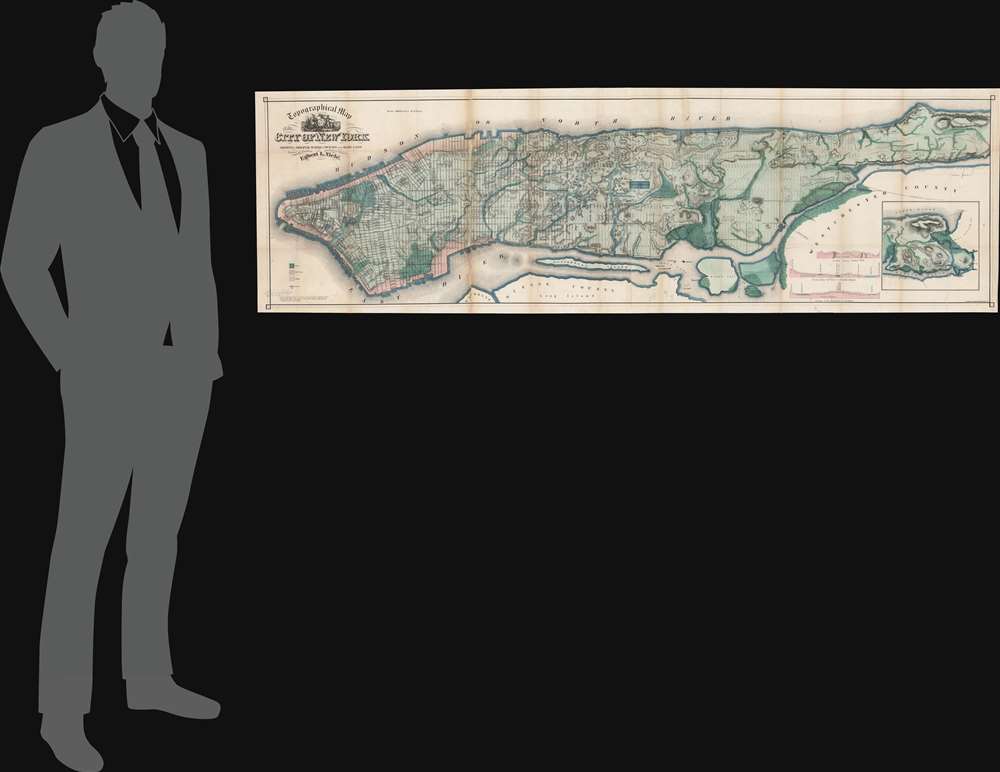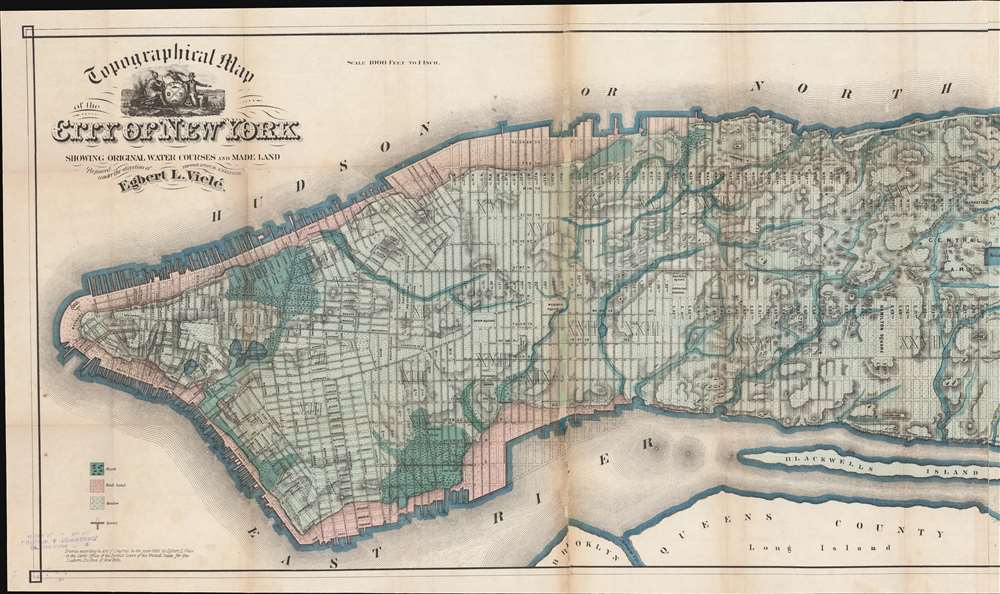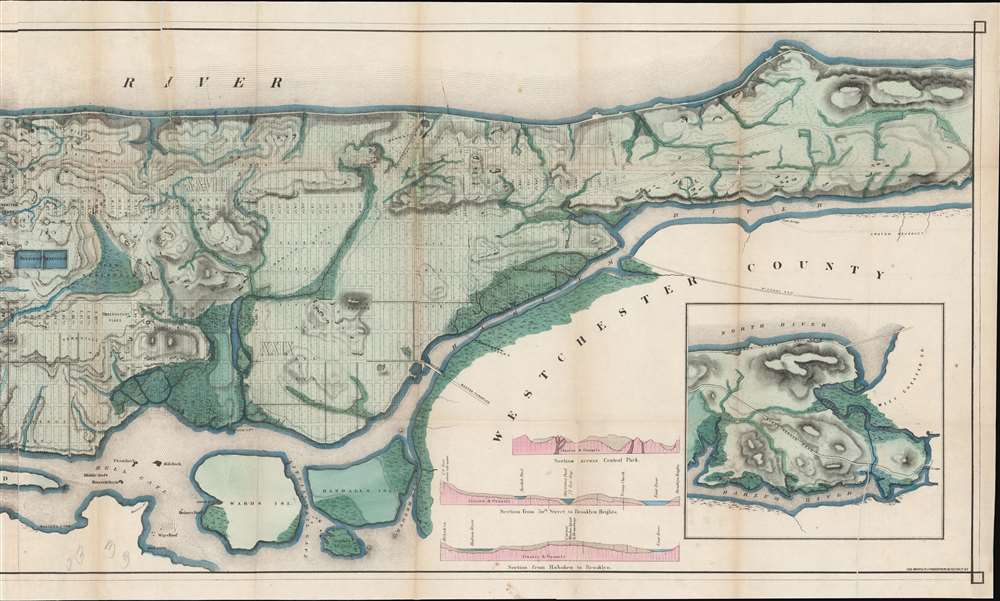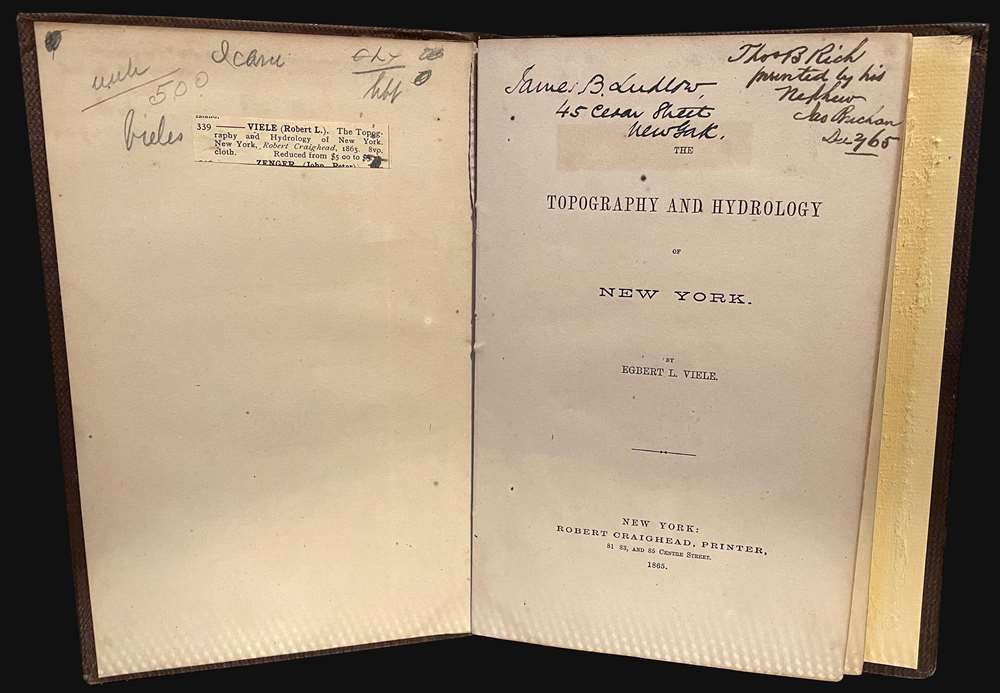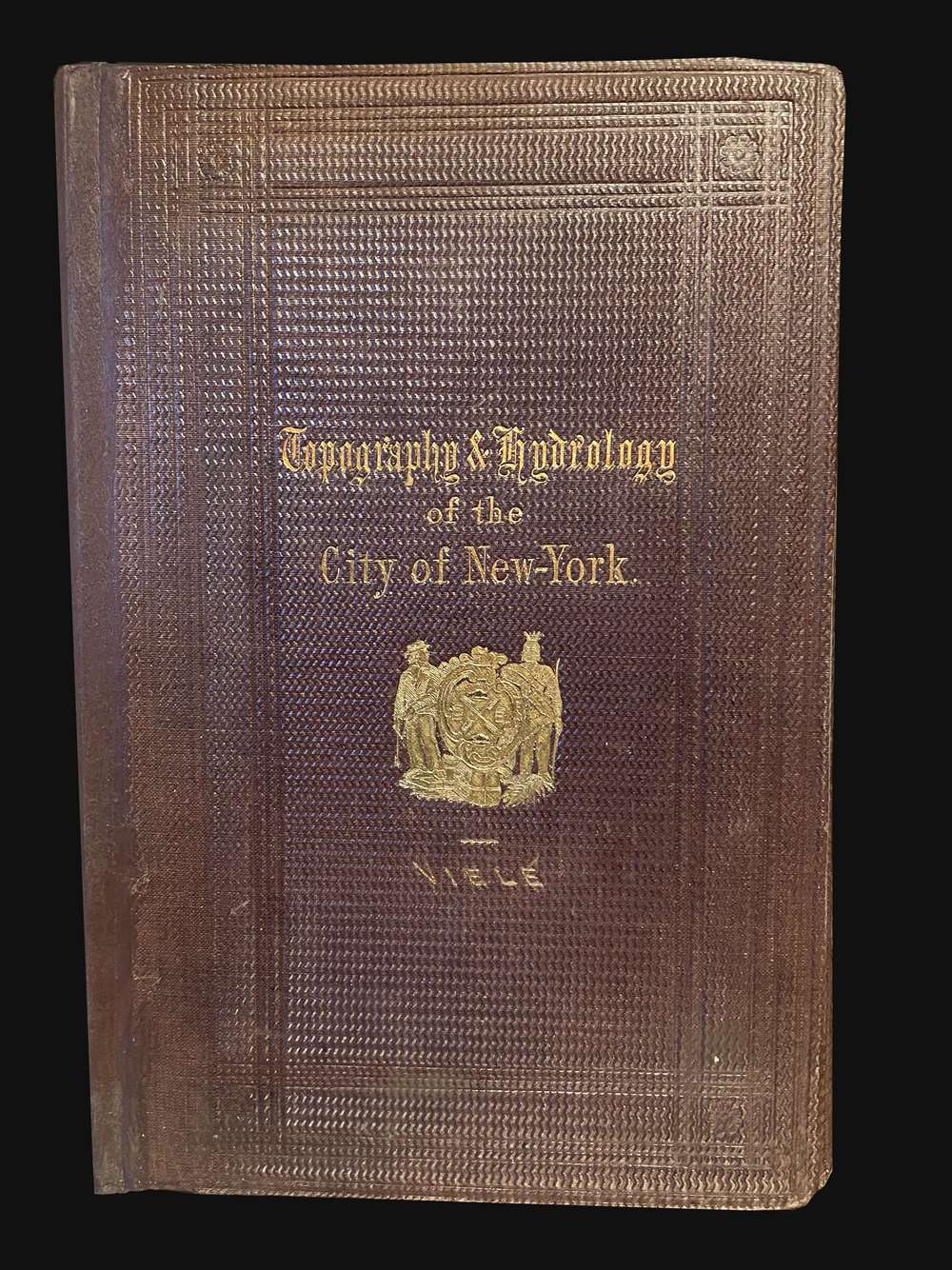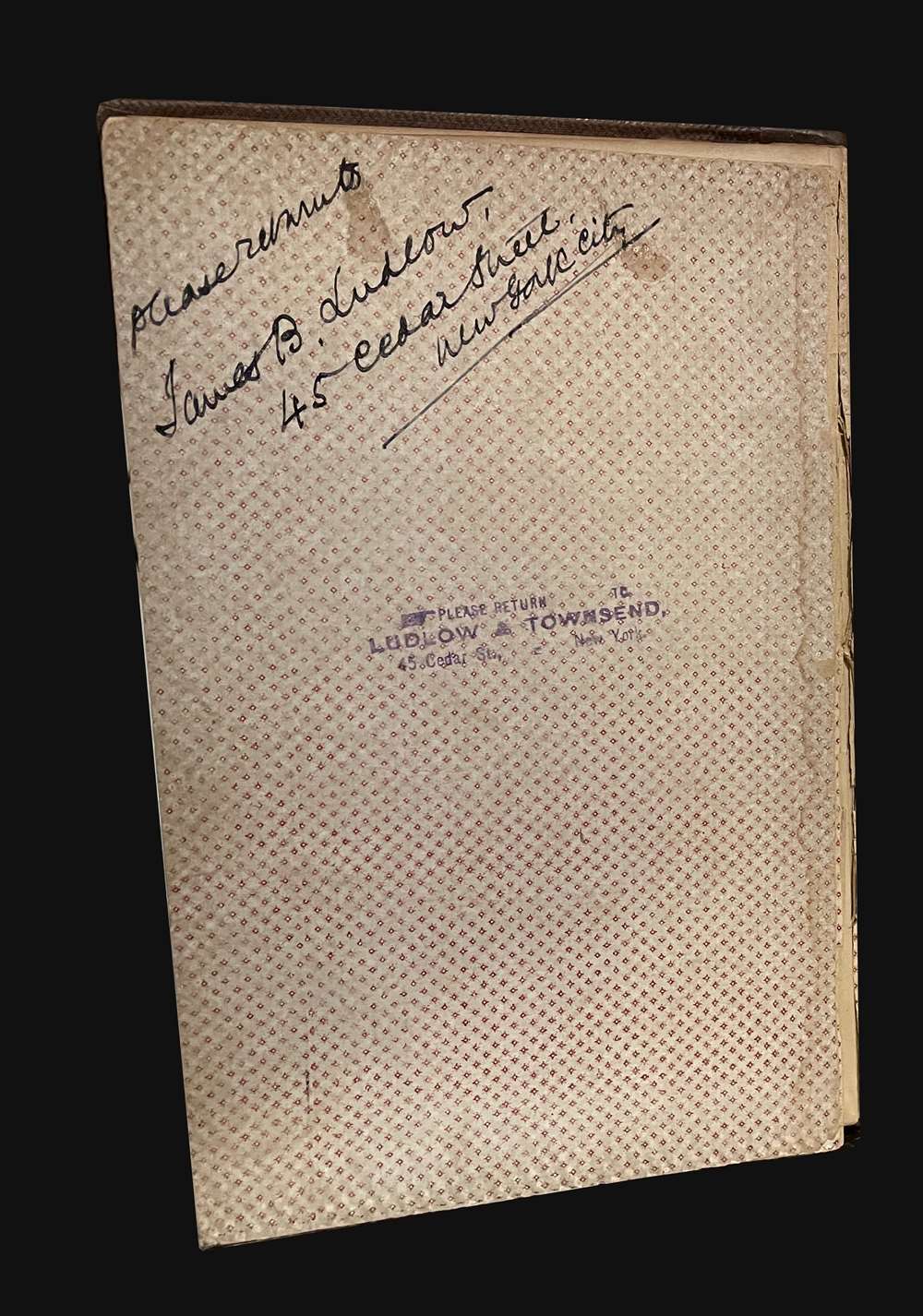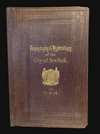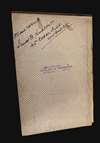This item has been sold, but you can get on the Waitlist to be notified if another example becomes available, or purchase a digital scan.
1865 Egbert Viele Waterway Map of Manhattan, New York City
NewYorkWaterways-viele-1865-4
Title
1865 (dated) 17.5 x 63 in (44.45 x 160.02 cm) 1 : 12000
Description
Viele's Hypothesis
Roughly translated 'Manhattan' is an American Indian term meaning 'Island of Hills'. The American Indians living in the region prior to the Dutch settlement of Manhattan treated the island as a huge hunting and fishing reserve full of trout streams, bass swamps, and sunfish ponds. Viele contended that as streets and buildings were constructed the city's natural drainage retreated underground where, stagnating, it led to a 'humid miasmic state of the atmosphere' conducive to yellow fever, malaria, plague, and other epidemic illnesses.Constructing the Map
Viele dedicated nearly 20 years to researching and perfecting this masterpiece of cartography. The basic map and above ground topography of the Viele map is drawn from John Randel's surveys of 1807 and the Commissioner's Plan of 1811, which formally laid out New York City's grid system. Viele then used early survey work, new survey work, and studies of older maps to recreate Manhattan's water system as it must have existed when the first Dutch settlers built a fur trading post at the southern tip of the island. Viele presented an unfinished early state of his map, covering only lower Manhattan to the New York State Senate in 1859, claiming,The Sanitary condition of any city or district or country is intimately connected with its proper drainage . . . that any inquiry into causes or remedies for sanitary evils . . . shall be based upon a thorough knowledge of the topography of the island.It took another six years of meticulous study to produce the final product – this extraordinary achievement.
A Most Enduring Legacy
Although Viele may never have imaged his map's most important legacy would be as a construction aid, architects, engineers, and contractors were quick to grasp its usefulness. Paul Starett, who built the Empire State Building and Stuyvesant Town, used this map to prepare estimates of construction costs. Melvin Febish, part of the team constructing the Citicorp Center, 'found that it is accurate within feet'.Provenance
The map bears signatures and stamps associating it with James. B. Ludlow, a Harvard graduate and New York Lawyer and one of the wealthiest landowners in turn-of-the-century Yonkers. His firm, Ludlow and Townsend, located at 45 Cedar Street, was prominent in real estate law, making this map especially pertinent to their work.Publication History and Census
This edition of Viele's Topographical Map of New York City was issued with his manifesto calling for future city development to take natural waterways and drainage into account when planning expansion. A separate issue, with a longer title, Sanitary and Topographical Map of the City and Island of New York appeared as a stand-alone map. Haskell, in his cartobibliography of Manhattan maps, for some reason identifies this map as being issued in 1864, but no known example exists from that date, nor are there any recorded copyrights on this map from 1864. The first complete editions were issued in 1865. There were, it is noteworthy, several variants issued simultaneously in 1865, all of which might reasonably contend for the title of first. These include a pocket format version and a variant issued for Viele's book on sanitation (this example), both of which were printed on banknote paper. There is also an edition printed on heavier paper for the official presentation. Cartographically all three editions are identical, but all have slightly different titles. Engraved by Ferdinand Meyer Lithographers of 96 Fulton Street, New York. This map has become increasingly rare on the market.CartographerS
Egbert Ludovicus Vielé (June 17, 1825 - April 22, 1902) was an American civil engineer, cartographer, businessman, and politician active in New York City during the second half of the 19th century. Born in Saratoga County, Vielé attended the United States Military Academy at West Point. Graduating in 1847, he was commissioned as a brevet second lieutenant in the 2nd United States Infantry. He served in the Mexican-American War before resigning form military duty to pursue a career as a Civil Engineer in New York City. When the call came to plan New York City's Central Park in 1856, Vielé was established as Engineer-in-Chief of the project, and it was he who set down the guidelines by which Vaux and Olmstead ultimately planned the park. He held a similar position as engineer of Prospect Park, Brooklyn from 1860. It was most likely during his tenure with the park commissions that Vielé developed his theories connecting compromised natural drainage with sanitation and infectious disease. Vielé's great cartographic masterpiece, the Topographical Map of the City of New-York, euphemistically known as the 'Vielé Map' or 'Waterways Map' evolved out of the notion that epidemic level disease evolved from excess moisture in the soil. He contended that, as New York City expanded northwards, paving over stream beds and leveling out natural drainage channels, the underground waterways would stagnate and lead to plague or worse. Though intended for the purpose of urban planning, the Vielé Map's (as it came to be known) greatest legacy is as a construction tool. To this day, contractors, architects, and engineers consult the Vielé map to determine if unseen subterranean waterways need to be taken into account when preparing building foundations. He was elected as a Democratic representative to the Forty-ninth Congress (March 4, 1885 – March 3, 1887) and ran unsuccessfully for re-election in 1886. He was heavily involved in New York real-estate interests, but also owned shares of mining and railroad companies as far off as Colorado. Vielé died in April of 1902 and was buried in an elaborate Egyptian Revival tomb at West Point. Legend tells that Vielé, paranoid that he would be buried alive, an unfortunate but surprisingly common problem in the 19th century, installed a buzzer inside his coffin that would allow him to ring the school's commanding officer should the need arise. Apparently, it did not. More by this mapmaker...
Ferdinand Mayer (October 19, 1817 - November 14, 1879) was a prosperous lithographer based in New York during the latter part of the 19th century. Mayer was born in Württemberg, Germany, but emigrated to the United States following the 1848 March Revolutions that swept through the German Confederation - maybe as late as 1854. Initially, Mayer was associated with various partners, including Prang, Nagel, and Korff - also German immigrants. By 1855, he established himself at 96 Fulton Street and, within a few years, expanded to the neighboring property at 98 Fulton Street. Meyer produced an enormous corpus of varied work, including music sheets, bank notes, broadsides, maps, and views. His career was probably jumpstarted through an early partnership with the important cartographer Henry Walling, many of whose maps and atlases bear the 'Ferd. Mayer' imprint. His most important publication is most likely Egbert L. Vielé's 1865 Topographical Map of the City of New York, one of the most important and influential maps of New York City ever published. The Mayer imprint appears on documents as, variously, 'Ferd. Meyer', 'F. Mayer', and 'Mayer and Sons'. Learn More...


